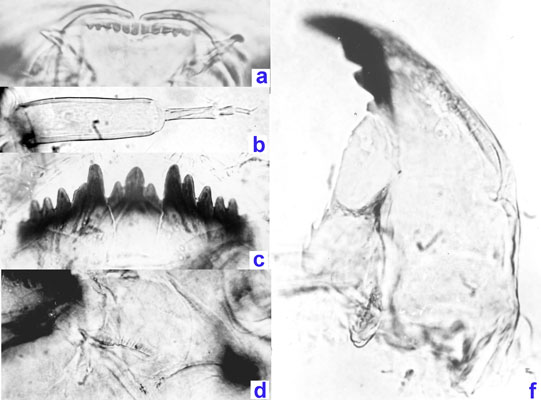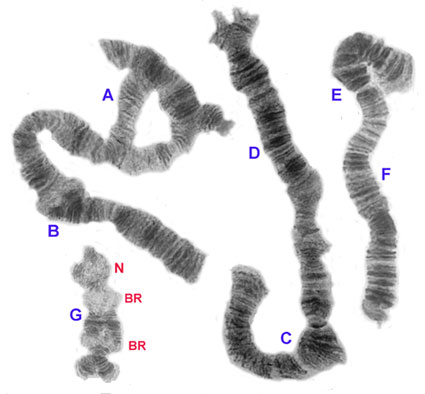Species 2a. Possibly C. decorus groupOnly two larval specimens of this species are known for certain, and only one was available for detailed morphological examination, and a further specimen represented by the polytene chromosome squash. Adult and Pupa not known. Fourth instar larva a small to medium (abt. 11.5 mm) plumosus-type; ventral tubules of moderate length; anal tubules relatively long, ventral pair longer (ant. 506; post. 582 µm) 5 times (ant) and 5.1 (post) times longer than wide.
Gular region dark over posterior half, slightly wider than the mentum, and a slightly darkened frontoclypeus.
Mentum (Fig. c, below): width about 0.58 of ventral head length; c1 tooth fairly narrow with short almost parallel sides, c2 teeth fairly well separated (type III). 4th laterals reduced about to level of 5th laterals (type II) and 6th laterals arising lower than than the other lateral teeth.
Ventromental plates (Fig. d, below) about 210 µm wide and 3.46 times wider than deep, 1.17 times the mentum width; separated by about 0.28 of the width of the mentum; with about 47 striae; VMR about 0.33. Pecten epipharyngis (Fig. a, below) with about 11-12 teeth (type B?). Premandible teeth broken, but inner tooth about 3.3 times wider than the outer tooth.
Antenna (Fig. b, below) with basal segment only about 35% of the VHL and about 3.1 times longer than wide, RO about 0.4 up from base of A1; AR abt 1.52; antennal proportions (µm) 109 : 39 : 12 : 12.5 : 8; i.e. A4 barely longer than A3.
Distance between the antennal bases about the same as the distance between the S4 setae, which are separated by about 88% of the width of the frontoclypeus; S5 setae about level with the nearby Ring organ.
Mandible (Fig. f, below) about 235 µm long, with 3rd inner tooth partly separated and slightly darkened (type IIB); 14-16 furrows on outer surface at the base; about 12-13 taenae in the Pecten mandibularis; Mdt-Mat 28 µm, MTR 0.34.  Cytology: 4 polytene chromosomes with the thummi arm combination AB, CD, EF, G.
Arm G usually paired, nucleolus subterminal with a Balbiani ring (BR) nearby and a further BR about one third from other end. Small nucleolus (probably usual bulb or BR of group 7) about center of arm B.. Centromeres apparent but not heterochromatic.
Polymorphic in arm A.
Arm A: Inversion covers over half the arm to within about 10 bands of the distal end.
Arm B Bulb with proximal dark bands (groups 7 & 8) near middle of the arm. Characteristic bands (21-28) near centromere.
Arm C: Characteristic constriction about a third from the centromere.
Arm D:
Arm E: ???, 4 - 3f, 10c - 13
Arm F: 1a-i, ???, 17 - 23.
Arm G: Subterminal nucleolus with nearby large BR, a smaller BR followed by a constriction about a third from the other end.  Found: Ontario - Bear Creek, Carlsbad Springs (45.37°N, 75.47°W), Carleton Co. Pools in creek. This species is recognised on the basis of the polytene chromosomes, with a relatively short, closely paired arm G which has a subterminal nucleolus closely followed by a large BR, then a second large BR followed by a constriction. See also C. decorus Joh., C. bifurcatus, C. sp. b, C. sp. c, C. sp. j, C. sp. z, C. 'proulxi', C. 'butleri', C. sp. 2t, C. sp. 3h, C. sp. 3i, C. sp. 3j, C. sp. 3r, C. harpi, C. blaylocki, C. decorus R & F., C. mozleyi, C. winnelli.[ Return to Index| Go to References ] |

